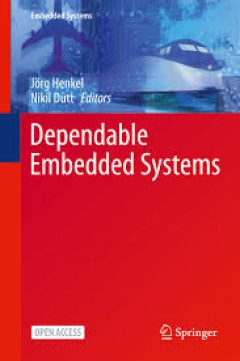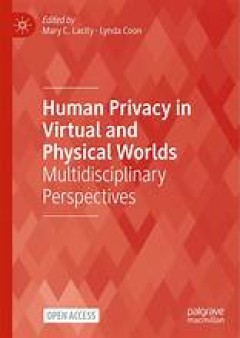Filter by

Embedded System Design : Embedded Systems Foundations of Cyber-Physical Syste…
A unique feature of this open access textbook is to provide a comprehensive introduction to the fundamental knowledge in embedded systems, with applications in cyber-physical systems and the Internet of things. It starts with an introduction to the field and a survey of specification models and languages for embedded and cyber-physical systems. It provides a brief overview of hardware devices u…
- Edition
- -
- ISBN/ISSN
- 978-3-030-60910-8
- Collation
- XXII, 433
- Series Title
- Embedded Systems (EMSY)
- Call Number
- 620 MAR e

Dependable Embedded Systems
This Open Access book introduces readers to many new techniques for enhancing and optimizing reliability in embedded systems, which have emerged particularly within the last five years. This book introduces the most prominent reliability concerns from today’s points of view and roughly recapitulates the progress in the community so far. Unlike other books that focus on a single abstraction le…
- Edition
- -
- ISBN/ISSN
- 978-3-030-52017-5
- Collation
- XIII, 608
- Series Title
- Embedded Systems (EMSY)
- Call Number
- 620 DEP

Urban Informatics
This open access book is the first to systematically introduce the principles of urban informatics and its application to every aspect of the city that involves its functioning, control, management, and future planning. It introduces new models and tools being developed to understand and implement these technologies that enable cities to function more efficiently – to become ‘smart’ and �…
- Edition
- 1
- ISBN/ISSN
- 978-981-15-8983-6
- Collation
- oer.unej.ac.id
- Series Title
- The Urban Book Series
- Call Number
- 004

Cyber Security : 19th China Annual Conference, CNCERT 2022, Beijing, China, A…
This open access book constitutes the refereed proceedings of the 18th China Annual Conference on Cyber Security, CNCERT 2022, held in Beijing, China, in August 2022. The 17 papers presented were carefully reviewed and selected from 64 submissions. The papers are organized according to the following topical sections: data security; anomaly detection; cryptocurrency; information securi…
- Edition
- -
- ISBN/ISSN
- 978-981-19-8285-9
- Collation
- X, 239
- Series Title
- Communications in Computer and Information Science (CCIS, volume 1699)
- Call Number
- 001 CYB

Human Privacy in Virtual and Physical Worlds
This open-access book is premised on the belief that understanding and protecting privacy requires a multidisciplinary approach. The editors of this contributed book believe that privacy is a ‘wicked problem’ because of its social complexity. In the modern world, political, social, and technological structures increasingly violate human privacy in physical and virtual spaces. Our behaviors …
- Edition
- 1
- ISBN/ISSN
- 978-3-031-51063-2
- Collation
- oer.unej.ac.id
- Series Title
- Technology, Work and Globalization
- Call Number
- 650

AI, Data, and Digitalization : First International Symposium, SAIDD 2023, Sog…
This open access book constitutes the revised selected papers of the First International Symposium on AI, Data and Digitalization, SAIDD 2023, held in Sogndal, Norway, during May 9–10, 2023. The 13 full papers included in this volume were carefully reviewed and selected from 42 submissions. The papers deal with the impact of data and AI on the digital revolution and their contribution to sol…
- Edition
- -
- ISBN/ISSN
- 978-3-031-53770-7
- Collation
- X, 203
- Series Title
- 1810
- Call Number
- 001 AID
Silicon Valley Cybersecurity Conference : Third Conference, SVCC 2022, Virtua…
This open access book constitutes refereed proceedings of the Third Conference on Silicon Valley Cybersecurity Conference, SVCC 2022, held as virtual event, in August 17–19, 2022. The 8 full papers included in this book were carefully reviewed and selected from 10 submissions. The contributions are divided into the following thematic blocks: Malware Analysis; Blockchain and Smart Contracts…
- Edition
- -
- ISBN/ISSN
- 978-3-031-24049-2
- Collation
- IX, 137
- Series Title
- -
- Call Number
- 001 SIL

Security in Computer and Information Sciences : Second International Symposiu…
This open access book constitutes the thoroughly refereed proceedings of the Second International Symposium on Computer and Information Sciences, EuroCybersec 2021, held in Nice, France, in October 2021. The 9 papers presented together with 1 invited paper were carefully reviewed and selected from 21 submissions. The papers focus on topics of security of distributed interconnected systems, sof…
- Edition
- -
- ISBN/ISSN
- 978-3-031-09357-9
- Collation
- XI, 133p
- Series Title
- -
- Call Number
- 001 SEC

Cyber Security : 18th China Annual Conference, CNCERT 2021, Beijing, China, J…
This open access book constitutes the refereed proceedings of the 17th International Annual Conference on Cyber Security, CNCERT 2021, held in Beijing, China, in AJuly 2021. The 14 papers presented were carefully reviewed and selected from 51 submissions. The papers are organized according to the following topical sections: data security; privacy protection; anomaly detection; traffic an…
- Edition
- -
- ISBN/ISSN
- 978-981-16-9229-1
- Collation
- X, 235p
- Series Title
- -
- Call Number
- 001 CYB

Oxygen-Carrier-Aided Combustion Technology for Solid-Fuel Conversion in Fluid…
This open access book surveys the development of OCAC technology in the last decade for solid fuel conversion in fluidized beds. The scientific concerns, including combustion and emission characteristics, ash-related problems, OC aging, and so on, are summarized and analyzed. Beyond this, new concepts like OCAC with Oxy-PFBC, OCAC coupled with staged fuel conversion, OCAC in rotatory kilns and …
- Edition
- 1
- ISBN/ISSN
- 978-981-19-9127-1
- Collation
- IX, 121
- Series Title
- -
- Call Number
- -
 Computer Science, Information & General Works
Computer Science, Information & General Works  Philosophy & Psychology
Philosophy & Psychology  Religion
Religion  Social Sciences
Social Sciences  Language
Language  Pure Science
Pure Science  Applied Sciences
Applied Sciences  Art & Recreation
Art & Recreation  Literature
Literature  History & Geography
History & Geography